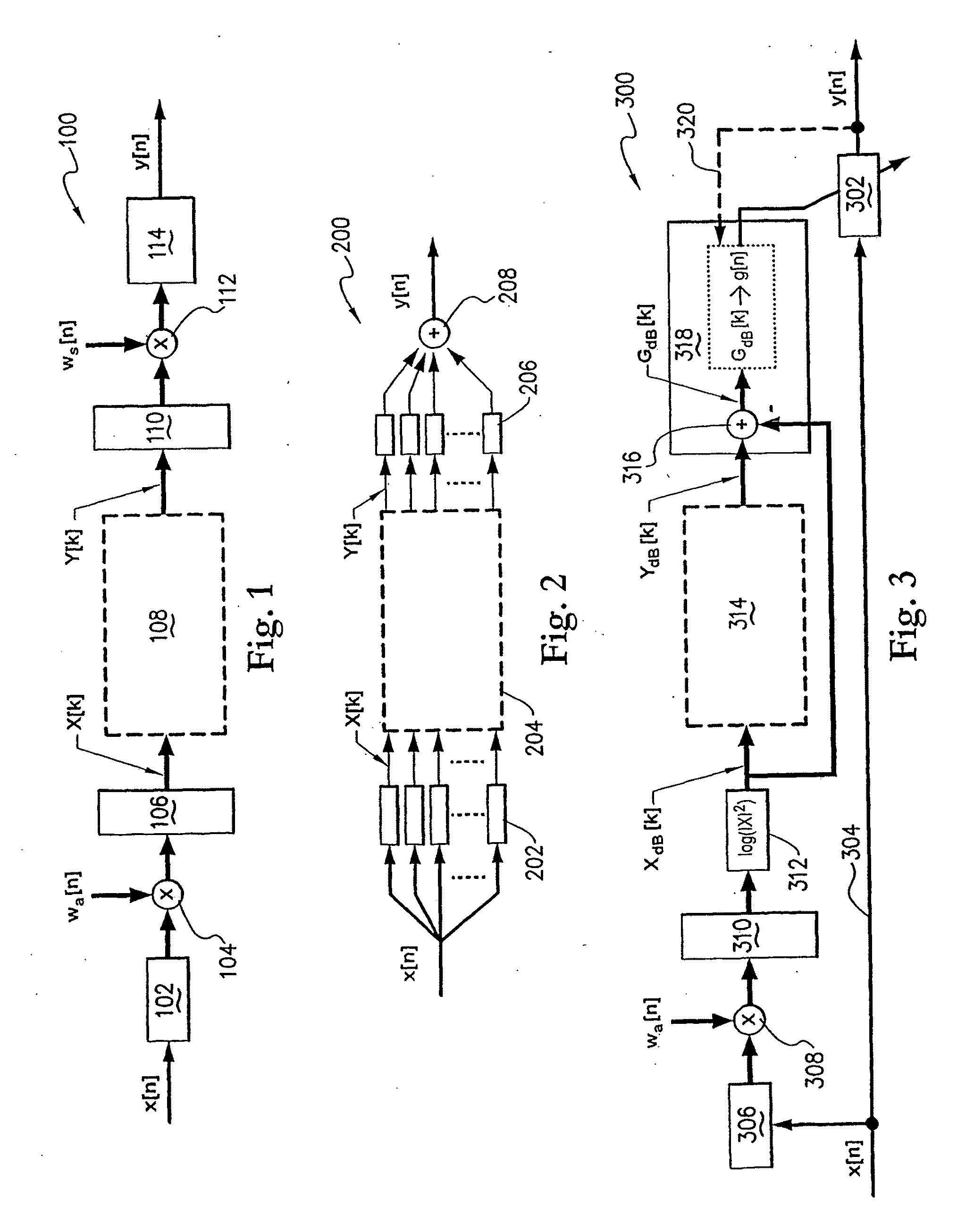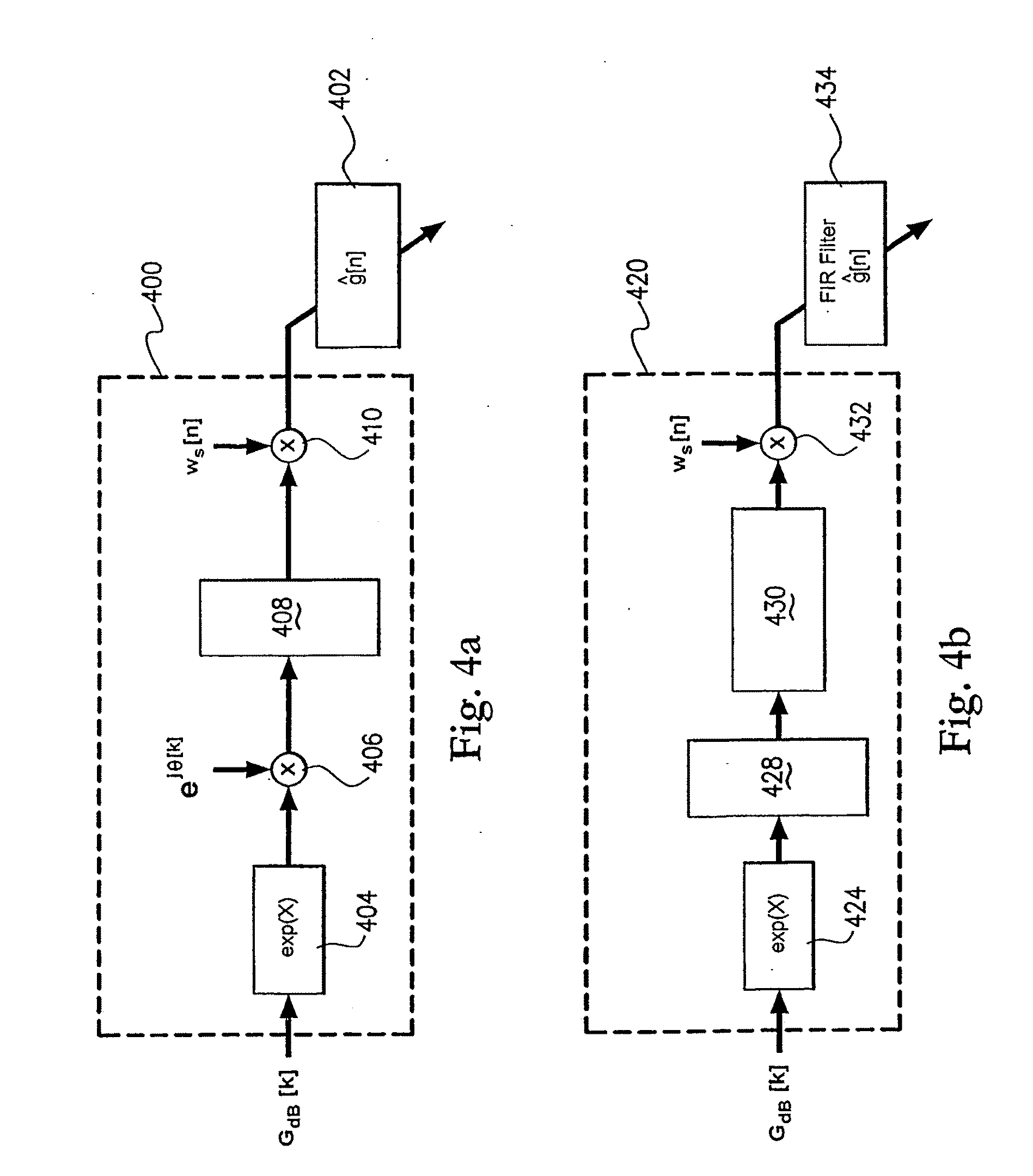Method and Device for Low Delay Processing
a low delay and processing method technology, applied in the field of signal processing, can solve the problems of group delay in the process, reduced control and integrity of delay differences, and perception coherence, so as to reduce the rate of gain variation and reduce such errors
- Summary
- Abstract
- Description
- Claims
- Application Information
AI Technical Summary
Benefits of technology
Problems solved by technology
Method used
Image
Examples
first embodiment
[0111]the invention set out in FIG. 3 recognises that the delay in the block based FFT mechanism 306, 310, 314, etc, is a requirement for the analysis of the signal x[n] only. Thus, the structure 300 of FIG. 3 provides for multi-band processing with reduced group delay using a computationally efficient FFT scheme by ‘de-coupling’ the signal analysis path from the processing path 304. This is achieved by using an offline analysis scheme that uses block processing for the analysis path, but adapts one or more time domain filters 302 to perform the processing of the signal x[n] at a single sample rate or reduced block size rate.
[0112]The circuit 300 of FIG. 3 performs multi-band analysis and processing based on log power domain (eg dB level) FFT analyses of the input signal, by provision of block 312. This is particularly convenient for many audio conditioning algorithms such as dynamic range compression or ADRO. Nevertheless alternate embodiments may omit block 312 and forgo log power...
fourth embodiment
[0140]FIG. 8 illustrates a filter realisation block 800 in accordance with the invention, using the cepstral minimum phase approximation technique for filter realization in the type of structure depicted in FIG. 3. An important advantage in combining the structures of FIGS. 3 & 8 is that block 312 provides for the core processing to be performed in the log domain (dB or other basis) prior to gain calculation and filter realization. This is particularly convenient for cepstrum calculations which require the input to be in the log domain. Therefore, in the flow of FIG. 3, the filter gain specification given by the real logarithmic gain values GdB[k] can be input directly to IFFT 804 for initial calculation of the real cepstrum c[q] in the flow of the filter design process of FIG. 8.
[0141]Once the real cepstrum c[q] of the log gain specification is calculated (c[q]=IFFT(GdB[k])), it is element-wise multiplied at 806 by a folding sequence λmin[q] to produce a modified cepstrum ĉmin[q]=λ...
fifth embodiment
[0148]While these or other windows may in some embodiments of the invention prove suitable for appropriate applications, an alternate cepstral implementation of filter realisation has been recognised by the present invention. Rather than attempt to choose or synthesize an asymmetric time domain window ws[n], spectral smoothing of the filter specification is obtained by recognising and exploiting another property of the cepstrum, referred to as cepstral smoothing, cepstral homomorphic filtering or ‘liftering’. The goal of such smoothing is to apply a low-pass or single sided function to weight the ends of the cepstrum. Since the ‘high exponential’ or ‘high quefrency’ components of the cepstrum generally represent the faster variations in the spectral domain, the spectrum can be smoothed if these components are weighted down relative to the ‘low exponential’ or ‘low quefrency’ components.
[0149]Cepstral filtering is therefore ideal for smoothing the minimum phase spectrum prior to trun...
PUM
 Login to View More
Login to View More Abstract
Description
Claims
Application Information
 Login to View More
Login to View More - R&D
- Intellectual Property
- Life Sciences
- Materials
- Tech Scout
- Unparalleled Data Quality
- Higher Quality Content
- 60% Fewer Hallucinations
Browse by: Latest US Patents, China's latest patents, Technical Efficacy Thesaurus, Application Domain, Technology Topic, Popular Technical Reports.
© 2025 PatSnap. All rights reserved.Legal|Privacy policy|Modern Slavery Act Transparency Statement|Sitemap|About US| Contact US: help@patsnap.com



